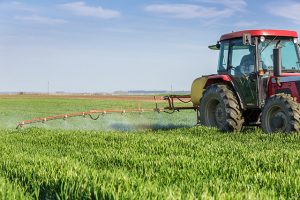
Pyraclostrobin — toxicity, side effects, diseases and environmental impacts
Thursday, November 23, 2017 by Earl Garcia
http://www.naturalpedia.com/pyraclostrobin-toxicity-side-effects-diseases-and-environmental-impacts.html

Pyraclostrobin is classified as a broad-spectrum fungicide that works against plant pathogens that belong to the ascomycete, oomycete, and basidiomycete fungal types. The chemical contains potent eradicative and curative properties that fend off various leaf and ear diseases such as leaf blotch, net blotch, and wheat stripe rust. An Agro Pages entry notes that the fungicide is commonly applied to staple crops including:
- bananas
- barley
- carrots
- berries
- peanuts
- peas
- onions
- tomatoes
- tree nuts
- wheat
List of known side effects
Pyraclostrobin exposure may occur through various routes such as through the respiratory tract and the digestive tract and through direct skin and eye contact. The Toxicology Data Network website notes that the hazardous fungicide is particularly detrimental to the lungs and may cause respiratory tract irritation and pain. Ingesting the harmful chemical may also lead to various digestive conditions such as gastrointestinal upset, weight gain, and stomach ulceration.
A data sheet published by the Minnesota Department of Health also shows that pyraclostrobin exposure may lead to hyperplasia and mucosal hypertrophy in the duodenum, increased liver and spleen weight, and diarrhea. The fact sheet reveals that the toxic chemical is detrimental to the circulatory system as well. According to the data sheet, exposure to the hazardous compound may lead to increased white blood cell and platelet count.
The fungicide is also associated with an increased risk of mesenteric lymph node apoptosis, delayed vaginal opening, and thymic atrophy. In addition, pyraclostrobin exposure may result in other conditions such as mucous membrane irritation, eye pain, pruritus, and skin redness as well as general weakness, headache, and dizziness. The toxic compound is also known to raise the odds of liver necrosis, forestomach acanthosis and both renal and hepatic issues.
Furthermore, an entry posted on the open chemistry database Pub Chem reveals that pyraclostrobin is found to contaminate water ways and affect aquatic ecosystems and animals as well.
Body systems affected by pyraclostrobin
Pyraclostrobin is particularly harmful to the respiratory system’s overall health. Likewise, the toxic chemical is found to impact the digestive tract and the central nervous system. The fungicide is also known to negatively affect the lymph nodes and both eye and skin health. The harmful compound is shown to impact the circulatory system, reproductive health, the kidneys and the liver.
Items that can contain pyraclostrobin
The Pesticide Properties Database website reveals that many trade name fungicides – such as Comet, Flyer, and Gemstone as well as Platoon 250, Vivid, and Tucana – contain pyraclostrobin as a key ingredient.
How to avoid pyraclostrobin
A safety data sheet issued by BASF Canada recommends wearing protective clothing, gloves, and respiratory equipment to reduce the risk of pyraclostrobin exposure. The data sheet also advises that workplaces install adequate ventilation to lower the odds of exposure. The safety guidelines stress that people exposed to the toxic fungicide should contact a poison control center or seek immediate medical help. The safety guidelines also recommend that people immediately evacuate the area to avoid direct contact if an accidental spill occurs.
Where to learn more
- Fungicide chemicals found to produce autism-like symptoms in animal studies, causing inflammation of the nervous system
- Contaminated HOUSE DUST found to promote growth of body fat
- Denmark discovers an alarmingly high concentration of pesticide poisoning in their population – school children are especially vulnerable
- Overused fungicides give rise to deadly, resistant fungus threatening humans and crops
- Exposure to common fungicide causes neurological problems across four generations
- Chemically induced autism? Scientist discovers pesticides, fungicides lead to neurodegeneration in test subjects
Summary
Pyraclostrobin causes respiratory tract irritation and pain, gastrointestinal upset, weight gain, and stomach ulceration.
Pyraclostrobin exposure leads to mesenteric lymph node apoptosis, delayed vaginal opening, and thymic atrophy.
Pyraclostrobin raises the odds of liver necrosis, forestomach acanthosis, and both renal and hepatic issues.
Pyraclostrobin is detrimental to the respiratory tract, digestive tract and the central nervous system.
Pyraclostrobin negatively impacts the circulatory system, reproductive health, the kidneys, and the liver.
Pyraclostrobin also affects the lymph nodes and both eye and skin health.
Sources include:
Tagged Under: Tags: Pyraclostrobin






